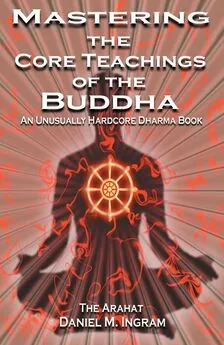Daniel Ingram - Mastering the Core Teachings of Buddha - An Unusually Hardcore Dharma Book
- Название:Mastering the Core Teachings of Buddha - An Unusually Hardcore Dharma Book
- Автор:
- Жанр:
- Издательство:Aeon Books
- Год:2009
- ISBN:9781904658405
- Рейтинг:
- Избранное:Добавить в избранное
-
Отзывы:
-
Ваша оценка:
Daniel Ingram - Mastering the Core Teachings of Buddha - An Unusually Hardcore Dharma Book краткое содержание
Mastering the Core Teachings of Buddha - An Unusually Hardcore Dharma Book - читать онлайн бесплатно полную версию (весь текст целиком)
Интервал:
Закладка:
Thus, the notion that there is someone who either will not be reborn again or will somehow cease to be (assuming they were “being” before), is absurd and doesn’t belong in the language of ultimate wisdom.
However, page after page, Buddhism promises that there will be no more coming into any state of being, no more rebirth, no more self, and that somehow this will get someone off of the wheel of suffering.
Here we get into as gray an area as it gets in spiritual language.
Between the weird promises of the Immortality Models and the weird promises of the Extinction Models, we can really get into paradigmatic trouble. Somehow we are sure that one of these must be right, or maybe both are, or perhaps neither are, or some other combination we currently can’t conceive of must be the correct one. However, all of these models are based upon a fundamental flaw, the misperception of sensations and the conclusion based on this misperception that there was some separate, permanent us that all these dualistic concepts can apply to. There is not, nor has their ever been, though sensations occur anyway. It is a convenient, practical, working assumption, a convention, a way of speaking, but nothing more. Thus, all of these curious notions simply do not apply. Simply practicing and perceiving sensations clearly reveals the way out of these paradoxes.
316
Models of the Stages of Enlightenment THE LOVE MODELS
On a completely different note, there are the Love Models. These are hard to relate to any previous category except perhaps the Emotional Models, but they essentially involve some combination of us loving everyone, feeling love all the time, becoming Love itself, being loved by everyone, or some combination of these. The first two are commonly found in various references, such as Sri Nisargadatta Maharaj’s famous quote, “Wisdom tells me I am nothing. Love tells me I am everything. Between these two my life flows.”
This is really not a bad quote as quotes go, as it tries to encompass the apparent paradoxes of spiritual understanding. It is basically a restatement of the Tibetan concept of balancing emptiness and compassion, and I like it for this reason. However, lots of people think that enlightened beings will be radiating love all the time, walking around saying loving things, feel profound love for all things at all times, and the like. Unfortunately, things couldn’t be further from the truth.
While it does get sometimes easier to take the wider world of beings into consideration as the center point is seen through, this is very different from walking around in a state of continuous love.
More sinister, deep, rarely articulated and yet compelling is the notion that somehow we will get enlightened and then people will not just like us, they will love us. Wow, does that one not withstand reality testing. Take the history of any of your favorite spiritual superheroes, the Buddha, Jesus Christ, St. John of the Cross, Rumi, etc. and notice the reactions people had to them. The notion that somehow you will be embraced, accepted, appreciated, respected, adored, cared for, or even liked by anyone just because of realization is, tragically, just another beautiful, delusional dream. In short, think twice before quitting your day job or walking down the middle of the street in your guru outfit proclaiming your realization for all to love.
Now, it is true that you can borrow a lot of pre-programmed respect from some people just by ordaining, which, viewed another way, means that ordination might get you the respect that your realization should, in some idealized universe, provide for you. However, this will be to a strangely select audience, and the games you have to participate in to be a part of that group are significant. You can also get a lot of respect by 317
Models of the Stages of Enlightenment
getting on some senior teacher list, but there are subtle forces that then come to bear that will have you denying a lot of your own humanity when in public, thus leading to the shadow sides I mentioned above.
These points also hint at the Social Models that will follow in a bit.
THE UNITY MODELS
Related to the Love Models are the Unity Models, those that
promise a palpable sense of your connection to everything else. This is another one of those models that contains some sort of truth, but is in fact one far extreme side of the unity/extinction paradox. What we generally imagine is that we will stay an agent, a separate, conscious, in-control being and yet will be part of everything in some mysterious way, such as either feeling everything else at all times or even more ludicrous, being in control of everything else at all times. I have already spent a lot of time on this model in the section called No-Self vs. True Self and in previous models, so will move on with the simple statement that those that believe in unitive models are missing something fundamental.
THE SOCIAL MODELS
In the same vein as the Love Models are the Social Models. These tend to involve all sorts of social implications or issues around enlightenment. For instance, we may imagine that enlightenment will automatically have certain desirable social implications, such as being accepted in a particular social role, such as that of a teacher, guide, mentor, spiritual friend, guru, leader, avatar, etc. This usually involves some poorly defined group of people accepting us. While spiritual attainments and unrelated qualities can sometimes inspire people to view us in these ways, there are absolutely no guarantees.
As I have pointed out before, plenty of people with wisdom have been ridiculed, ostracized, persecuted, attacked, jailed and murdered when they spoke from that place. In short, any social implications of one’s realization (assuming one is correct in claiming or believing it) will be at the mercy of ordinary causal reality, just as with everything else, and ordinary causal reality can really suck sometimes. Further, the vast majority of people don’t really have any clue what enlightenment is about, don’t think that enlightenment really exists today, may not have enlightenment as part of their view of what possible or even desirable, 318
Models of the Stages of Enlightenment or may even find the notion that you think you are enlightened to be a threat to their religious beliefs or an indication of your grandiosity, arrogance, delusion, or psychosis. Having lived with these issues for over a decade, I can tell you that these reactions are as likely to be found in the social circles of Buddhism as they are in the social circles of any other meditative or non-meditative religious or non-religious tradition.
Other Social Models involve enlightenment having something to do with other people’s opinions regarding whether or not we are enlightened, meaning that enlightenment is purely a social convention or collective designation and has nothing to do with reality or the individuals perception of it. In this model, just as we may elect a president (or at least believe we are casting votes for one), so it is with enlightenment. This is actually fairly common in a number of Western Buddhist circles, including some major retreat centers, in which they all bow to the senior teacher list and yet hold the paradigm that no one really gets enlightened. While all basically the neurosis of spiritual children, there are actually some real, practical truths hidden in this model.
While our direct perception of reality will depend on our practice and insights, any attempts at directly promoting similar insights in others will be greatly helped or hindered by what people think of us, whether or not we are given some title, whether or not a lineage accepts us as a teacher in that lineage, and whether or not the concepts and language we use to describe and sell our realization fit in with the cultural expectations and norms of our social circles. Further, there are those who falsely think they are enlightened because someone else thinks they are, and plenty of people on senior teacher lists that probably shouldn’t be there.
One way or another, it is worth examining our deepest beliefs regarding the social implications we imagine will occur when we get enlightened or more enlightened. These can have a big impact on our practice, our motivation to practice, and what kind of successes and failures we have in spreading insights around once we have insights ourselves. Unfortunately, most of our beliefs are likely to be somewhat unrealistic, springing from the understandable human need for 319
Models of the Stages of Enlightenment
recognition, role, and social status. Again, the further we find our dreams from our current reality, the more we need to look at what is happening right now, with those dreams and needs being one small part of the transient, causal sensations that are arising and vanishing.
Stated in practical terms and by way of example, you could be a foreign medical grad that had trained well in some foreign school, completed a good foreign residency, be perfectly qualified to practice from the point of view of knowledge, experience and talent, and yet not be allowed to practice in the United States until you had jumped through all the hoops. The same problem can arise when people go outside of a tradition or partially outside it and yet do very good insight work. They have the knowledge but not the social designation. Like the Tin Man in the Wizard of Oz who lacks a diploma, those who are enlightened who have not gone through standard channels can run into problems. That said, it also gives the freedom to speak out without worrying about those channels liking what you say, and there is much about the standard channels to speak out about.
I myself exist in a gray area like this, as do many modern teachers. I have accomplished much using the techniques of the Theravada, a tradition that explicitly says that only monks can know what I know and usually only recognizes monks as lineage holders. This is a cultural and social problem, and highlights the truth embodied in the social models.
I suspect there will be a lot more of this as the dharma moves into the modern era and more people are successful. We need to come up with solutions to this problem that neither artificially elevate people nor artificially prevent them from sharing what is they know that is of benefit to others.
THE THREE YANAS
While I am generally a die-hard fan of the Theravada, I have a great appreciation for much of the rest of Buddhism and the world’s other great mystical traditions. In that spirit, I offer the following. Traditional Tibetan training is broken down into Three Yanas or vehicles: the Hinayana, the Mahayana and the Vajrayana. These correspond very nicely to the needs of practitioners at various stages of the Simple Model presented above.
320
Models of the Stages of Enlightenment The Hinayana is a set of techniques and practices that closely resembles many of the traditional trainings of the Theravada, and these are often confused for this reason. (There are some historical relationships between the two that I do not wish to go into.) The Hinayana’s emphasis is on basic morality, stabilizing the mind, and looking into the Three Characteristics, i.e. all of the fundamental practices and emphases that I mentioned in Part I. It is designed to get a person to the first stage of awakening, i.e. first path, which the Tibetans would call third path in the Tibetan Five Path Mode, or attaining the first bhumi.
Getting to the next stage of the simple model or third path involves a deep appreciation of interconnectedness in real time and a willingness to surrender to it. The Mahayana path provides methods for
understanding this in abundance with its strong emphasis on helping others and on the intrinsic emptiness (“shunyata”) of phenomena. The Bodhisattva Vow, a fundamental part of the Mahayana path, not only expresses a deep willingness to surrender to and understand
Читать дальшеИнтервал:
Закладка:





![Дженнифер Гюнтер - The vagina book. Главная книга для тех, у кого есть этот орган [litres]](/books/1061538/dzhennifer-gyunter-the-vagina-book-glavnaya-kniga-dl.webp)




